
Davy Jones’ Locker: The Kraken Waves is a cooperative pirate-themed game that was on Kickstarter back in August 2022: It promised delivery in July 2023, and I received my backer copy in Early August 2023. That’s maybe just a few weeks late, which is great by Kickstarter standards! Seriously, the last five Kickstarters we have received have been either early or on-time! Let’s hope this trend continues!
Davy Jones’ Locker: The Kraken Wakes is a cooperative pirate game (if you couldn’t figure that out from the name or pictures).
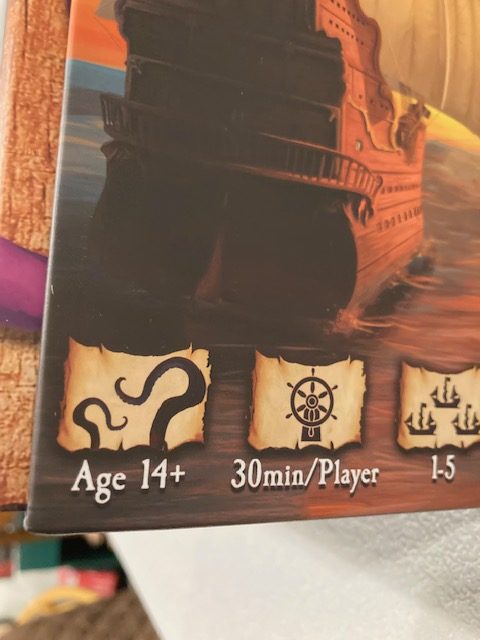
This is a game for 1-5 Players, Ages 14+. The game box (above) says 30 minutes per player, but that is not at all what we experienced! It felt much longer! A solo game took about 2.5 hours, a 2 Player games took about 3 hours. A better metric might be: 2 hours + 30 minutes/player?

Interestingly, the game “base rules” all seem to apply to games of 2-4 players. The solo rules and the 5-Player rules are exceptions. This bothered my friend Sam so much that he chose to back-out of a 5-player game we had planned because he was worried about the time/extra rules overhead. Be aware: the game does seem tuned for 2-4 players, but just happens to have rules for solo and 5 players.
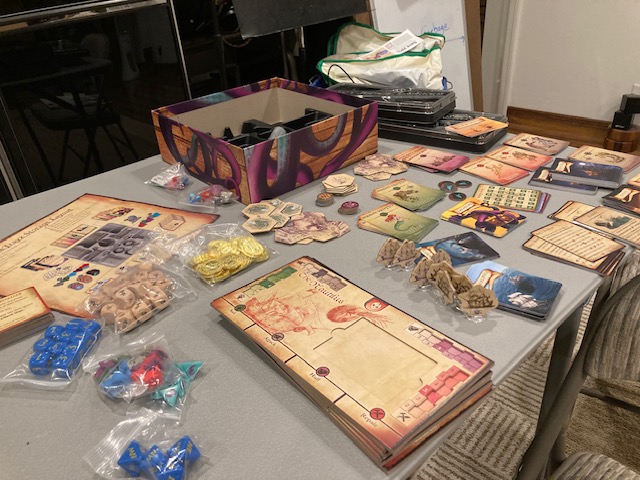
Let’s take a look at this cool pirate game! Will this make our Top 10 Cooperative Swashbuckling Games? If ye wants to be a mutinous pirate and see, jump to ahrrrrrrr Conclusion!
Unboxing
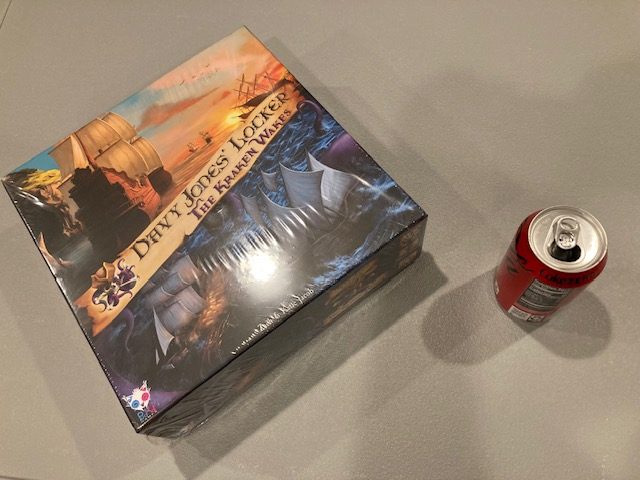
This is fairly normal sized box: see the Coke Can above and below for scale.
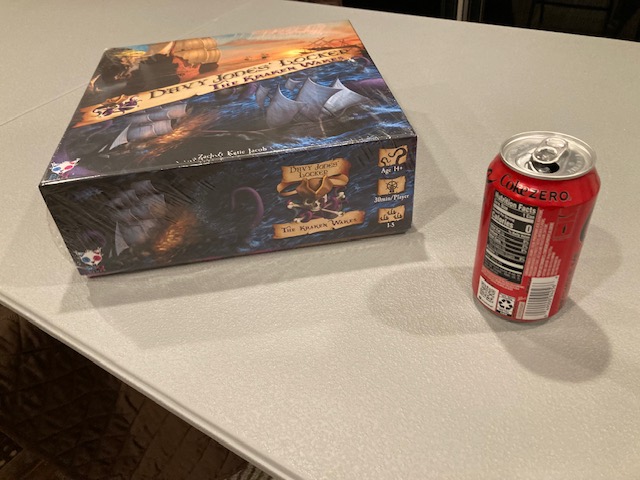
Note that the game seems to not all quite fit in the box: this is a very tightly packed box! Unfortunately, it’s still a little overpacked after you rebox it as well. It’s not a big deal, but it was a bit noticeable.
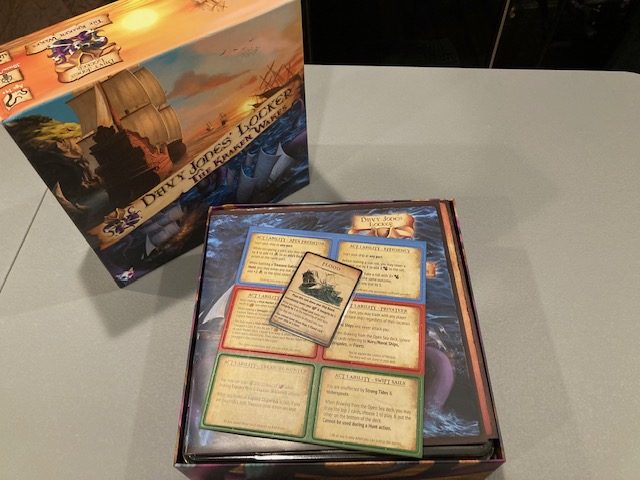
See above as we unbox!
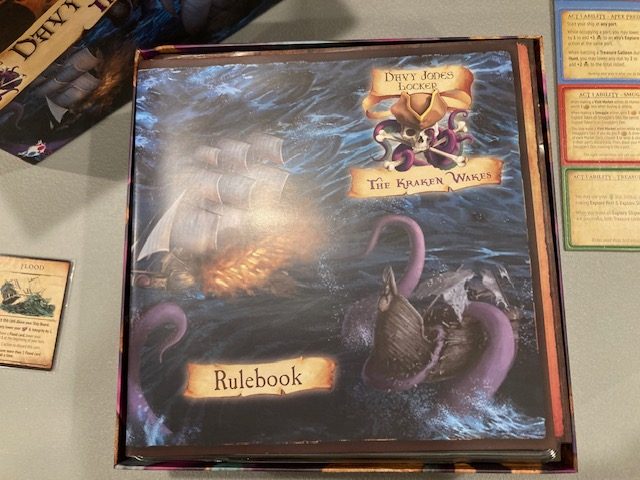
The rulebook has a great cover, and fits to the shape of the box.
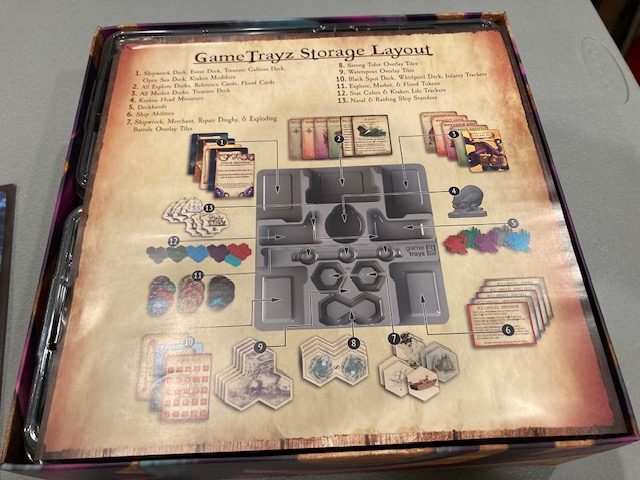
This game (other than sightly overpacking) has really thought about how to fit just about everything in the box! It has great directions for putting cards and tokens into the bottom of the box: see the insert above. And on the other side of the insert…

There are also GameTrayz (sp?) for ease of storing many pieces. You do have to unbox a lot of things to get them in there, but it really does make set-up and tear-down easier. See above and below.
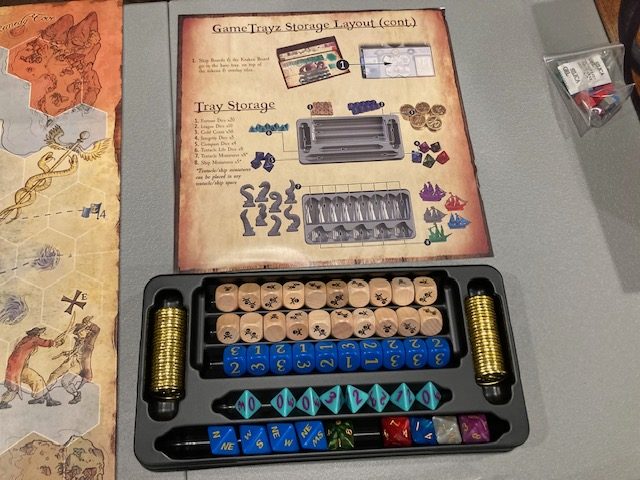
The dice all fit into one of the GameTrayz pretty well: the 4-sided (used for marking Tentacle Hit Points) and 8-sided dice (used for notating hull and direction) felt like they fit, but sorta weirdly. It worked well enough. The 6-sided wood dice were fantastic and very thematic, with little pirate symbols on them! The gold coins were real metal and very cool as well.

The tentacles and ships fit nicely in the other GameTrayz.
Underneath all the GameTrayz are a bunch of stuff ..
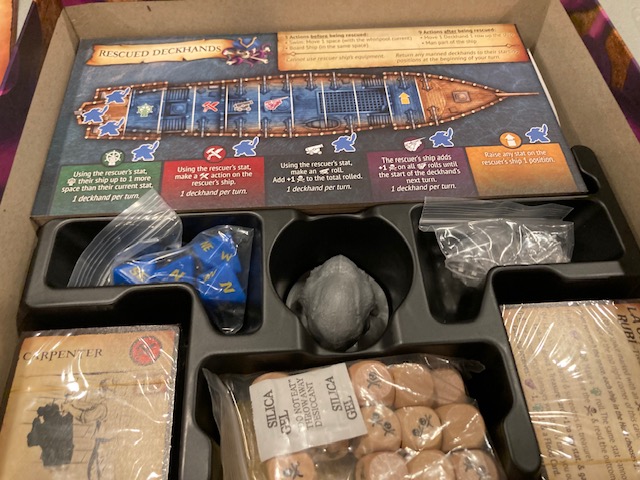
As you pull everything out of the box, you get a little worried … “Is this all going to fit?”
There were a ton of punchouts (see above) which all seemed to fit nicely into the insert at the bottom of the box.
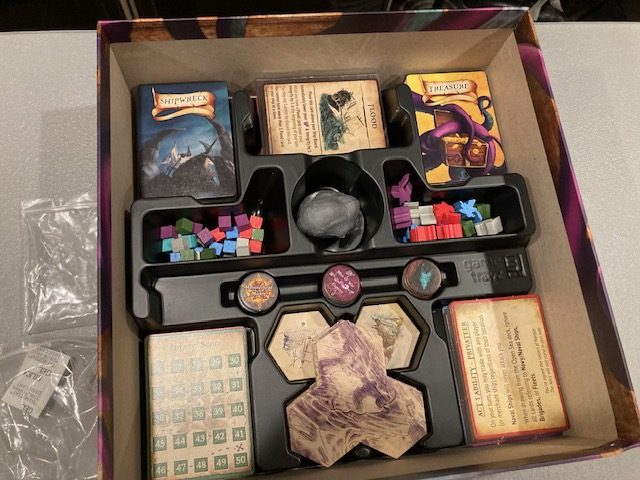
And you know what, it does fit all nicely in the box (modulo being just a touch too tall): see above.

Oh yes, and the player boards and nice and dual-layered: see above.
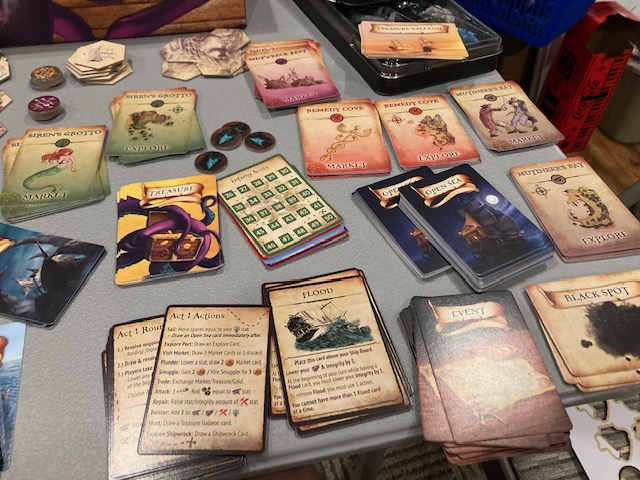
The cards are all linen-finished and look very piratey. The art is nice, if weirdly a little inconsistent: some card backs have really nice, almost painting-quality art, but some have more pencily art, and some art looks like just old prints. Despite the inconsistency in style, the art still works in this pirate game.
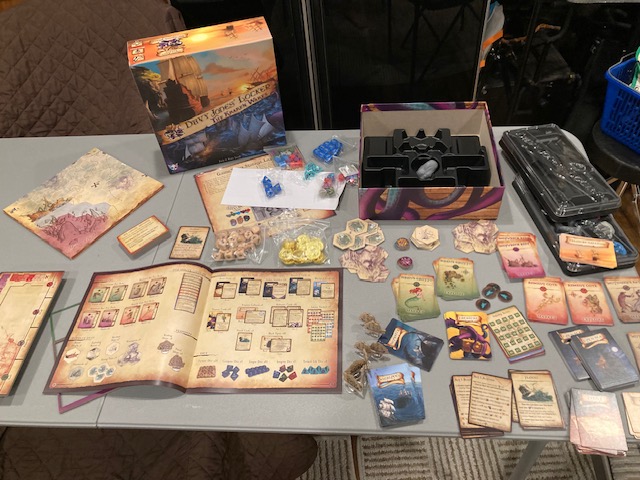
Overall, the components are very nicely done and the game looks like a cool pirate game.
Rulebook
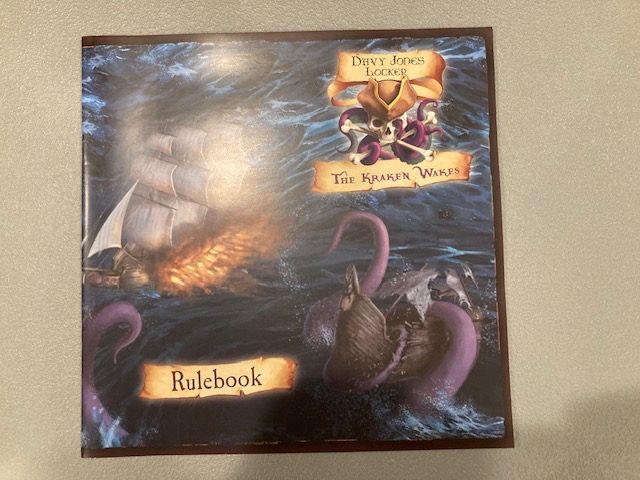
I struggled with this rulebook. It’s not a bad rulebook, but it could been better. I mean, I do love that cover!
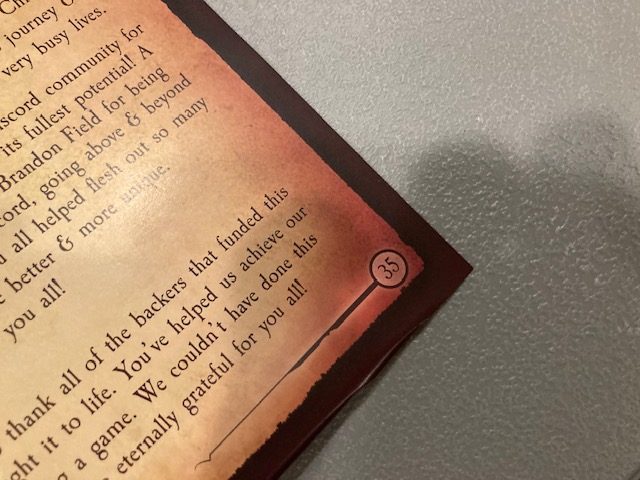
Part of my struggle may have just been the length: this rulebook is LONG: it’s 36 pages! Sometimes that extra length is used for flavor or scenario text. Nope: Not here! This rulebook is pretty much all rules! It’s a heavier game than I expected.
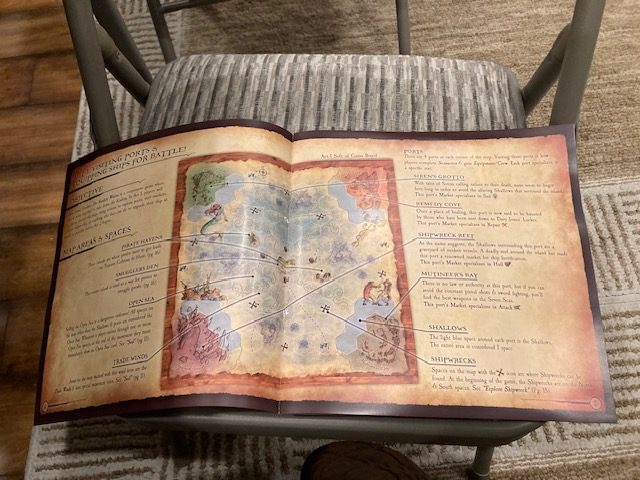
The game gets a B- or C+ on the Chair Test: It has a big font which you can read (good), it stays open when you place it down (good), but it kinda flops down on the edges when you put it on the chair next to you (bad). I think it worked just well enough to use the chair next to me.
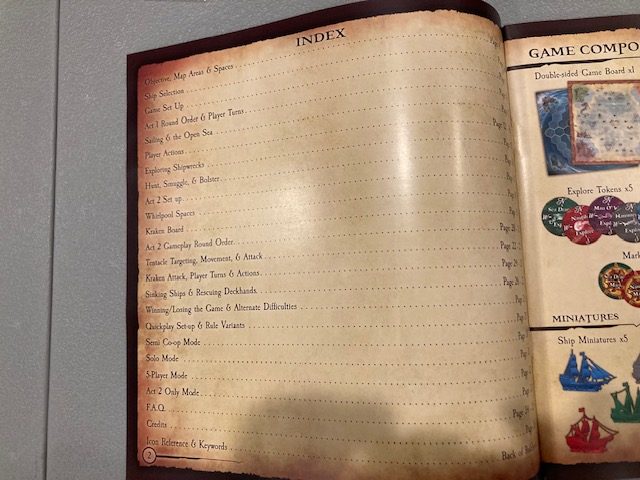
I think I was a little grumpy with the rulebook right away because it started with a Table of Contents (listing the major headings in order) … but called it an Index instead. I’ve seen this in other games and it’s a pet peeve: A Table of Contents lists major sections in order, and an Index notates important keywords and where to find them in the text. This is a pet peeve because it belies not understanding standard book nomenclature … and it has me worried they’ll get other stuff wrong.
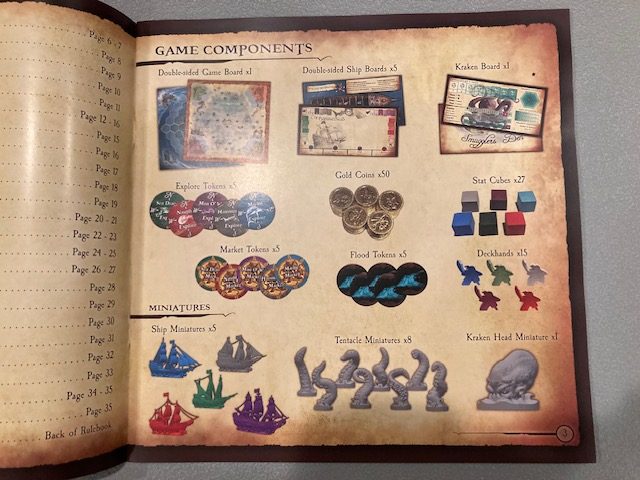
The Game Components were well-labelled across two pages.
I appreciate the extra space they took to list and label all the components. Sometimes, when the rules refer to a component, it’s nice to be able to look stuff up.
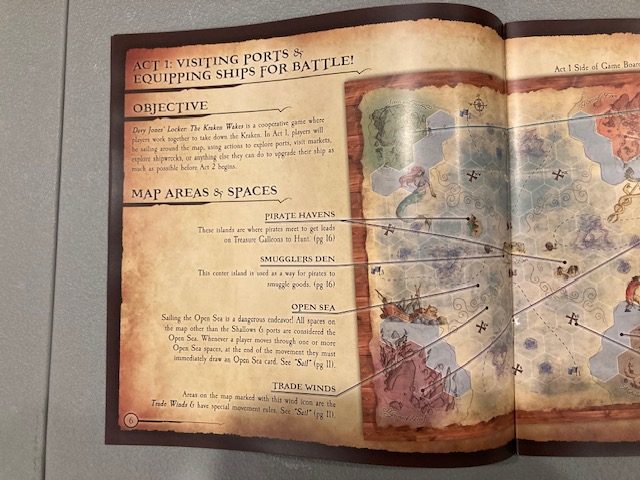
There’s a nice overview of the map as we start into the rules. See above and below.

It did have me wonder if maybe the board should have been LABELLED with the annotations rather than having to look them up? That’s a tough one, because the board does look nice, and adding annotations would make it busier and less thematic. I think they made the right choice from a theme perspective, but I always think that it’s better when the components and spaces are well-labelled so you don’t HAVE to look up stuff in the rulebook.
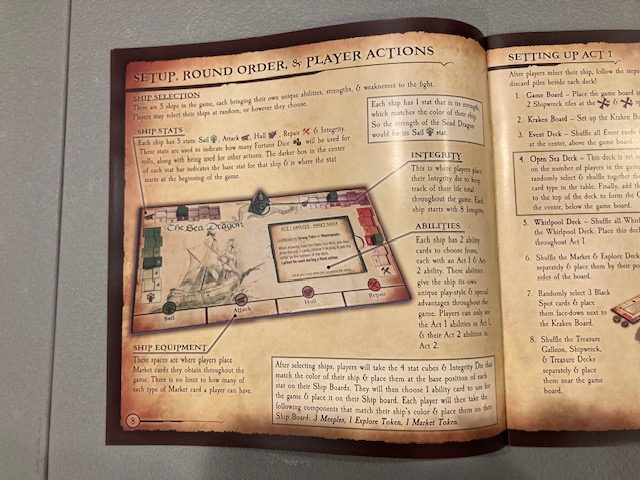
The set-up pages were pretty well done.
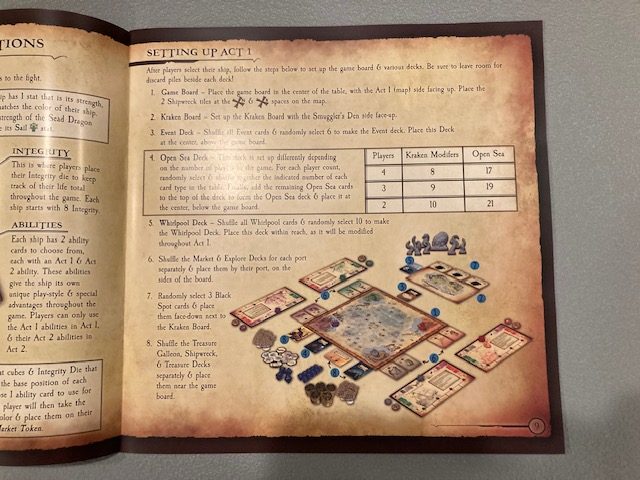
It’s just .. I started out with a solo game (which I strongly suspect most people will) because I wanted to learn the game before I taught my friends, and the solo rule were an “exceptional” case relegated to the back of the book. Look closely at the set-up:
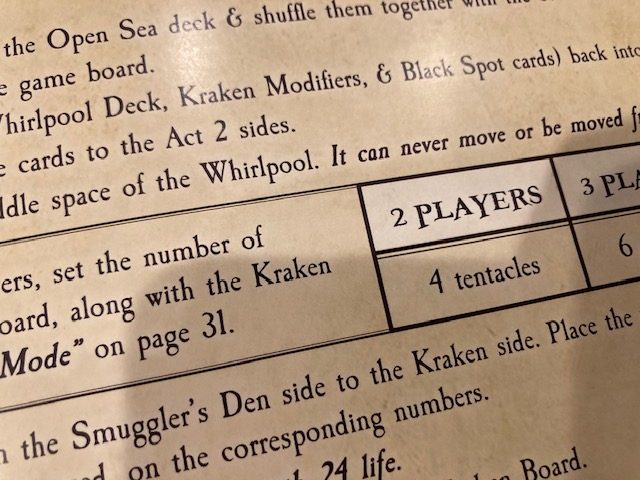
The set-up ONLY discuss 2, 3, and 4 Player set-ups! If you want solo play, you have to go out of your way to find those rules in the back of the book. Again, I suspect many people will play this solo first so they can teach their friends, and the rulebook doesn’t make that flow easily. Gameplay is optimized for 2, 3, and 4 players. Solo and 5-Player games are the exceptional cases.
There’s a lot of text in the rulebook, and there could be more figures. And even so, there still were times when I thought the game was underspecified (Example: when a whirlpool moves you, how do you move? Along the current? When you get pushed out by the whirlpool, is that an extra move? Where do you get moved to? Frequently there are multiple choices…)

Look, this game has a lot of rules, and occasionally under-specifies a few of these rules. BUT, the rulebook is very readable, and it has a big font., and even though there are problems with the rulebook, it makes a good faith effort of putting forth a good pirate game and mostly succeeds. Let’s just move on: I was able to learn the game from the rules, so that’s a win.
Gameplay: Overview
This game proceeds over two Acts. In Act I, players work together to try to upgrade their ships to make them “sea-worthy” : players are exploring and doing all they can to get their ship shipshape. In Act II, players use their upgraded ships to fight the Kraken: if they can take out the Kraken, they win! You’ll note that the player board (above) has two sides: Side I is the map where players explore and upgrade (Act I) and Side 2 is the whirlpool where player fight the Kraken (Act II)!
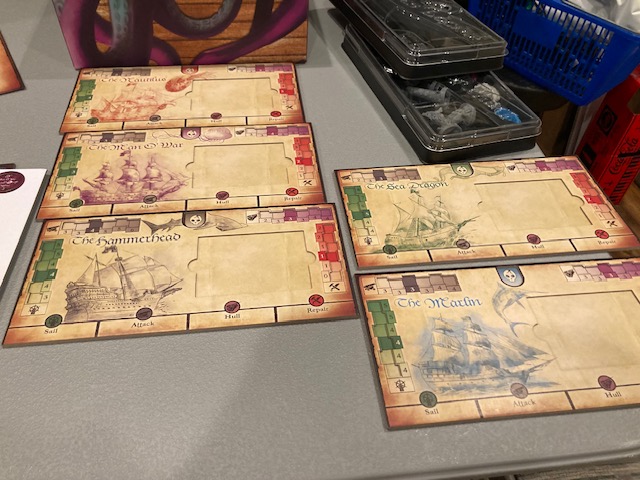
At the start of the game, each player selects one of 5 ships to man.
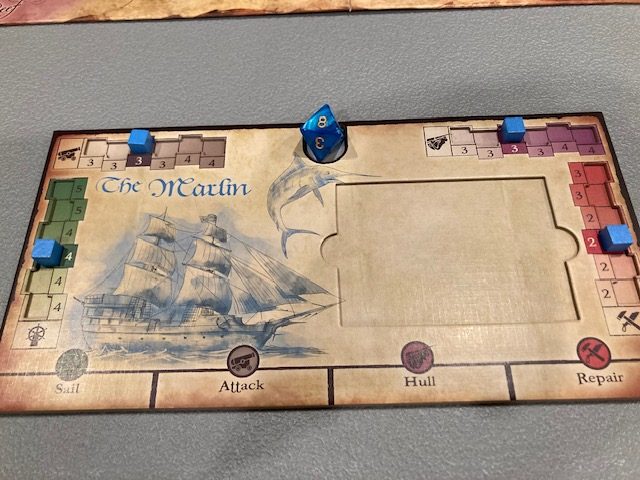
Each ship has 5 main stats notated on 4 different tracks and 1 8-sided die.
- sail (green) is how many movement points you have. Normal sea costs 1 movement point, other “rougher” seas cost more
- cannons (brown) are how many dice you get to roll when you attack.
- hull (purple) are how many dice you roll when you defend
- repair (red) is how many spaces you can repair other attributes (including repair) if they get lowered.
- integrity (8-sided die) is your “hit points” for the ship: how much damage your ship can take until it sinks
You can’t repair your ships attributes above the default unless you get a special card that ups that stat … the slots underneath the ship are for those special upgrade cards.
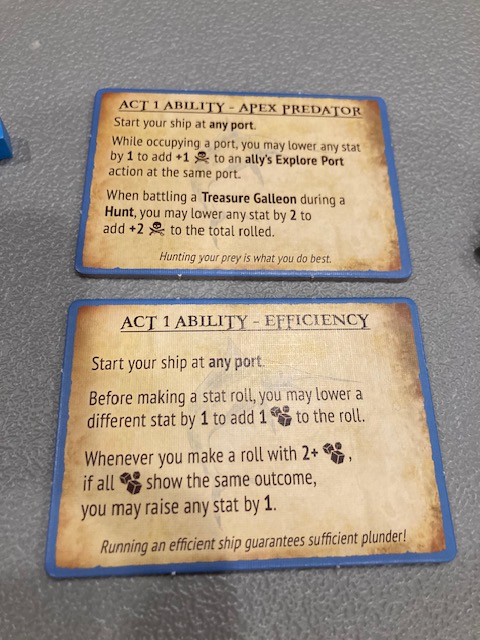
Every ship has a special ability, or rather a choice (one of two): See above: You get to to choose one. That ability changes in the second Act: it flips to the other side (so pay attention to both sides).

During the Act, players will be upgrading their ship (upgrading stats and getting upgrade cards) and getting gold: gold in Act I is how you buy upgrades, but gold will be used for re-rolls in Act II. See above for an upgraded ship!
Get the best upgrades you can in Act I to fight the Kraken in Act II!
Gameplay: Act I
Act I is all about the upgrades. Pirates do “piratey” things (plunder, explore, fight) to get gold so they can buy upgrades to their ships!
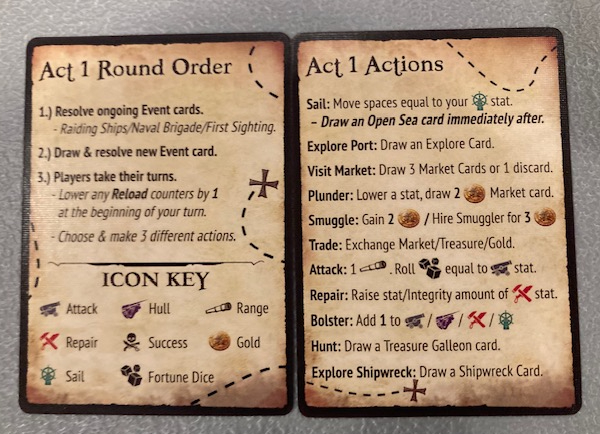
In Act I, players deal with an Event every turn, then get three Actions each. See above for the very good player summary cards! (Seriously, these were very helpful).
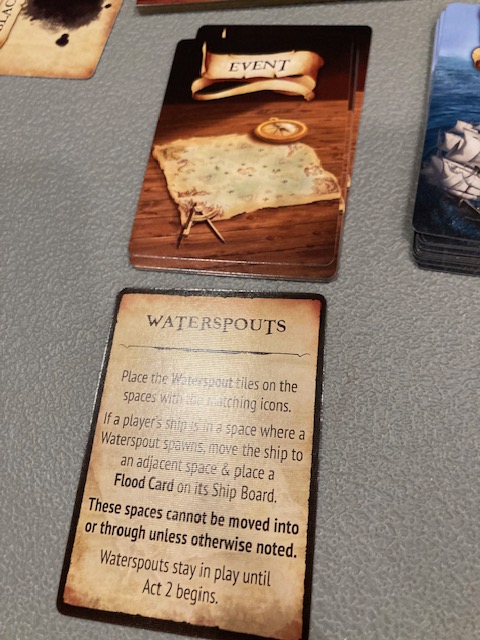
Events (see above) in Act I are generally good things: they set the stage for some “piratey” things to happen, which nudge the players in certain directions. For example, the Exotic Goods card puts the Merchant Ships into play, encouraging platers to “pirate” them to get good stuff. The Events can also be bad, but generally are helpful.
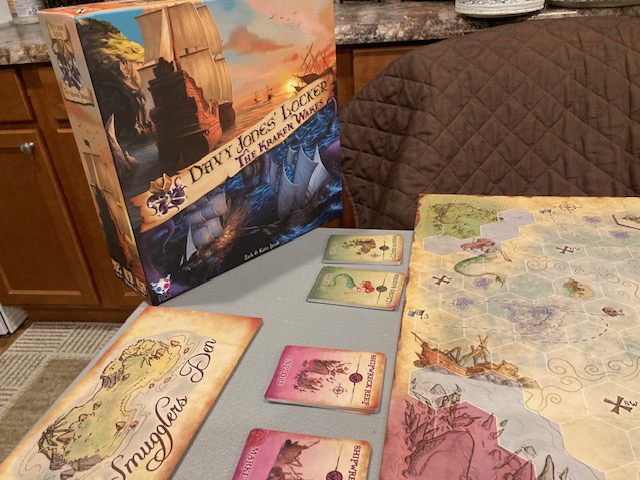
Once the Event is resolved, each player get three actions. The most common actions (at least among me and my friends) were the Explore, Plunder, or Visit Market actions: These are generally the most reliable way to get upgrades. These actions must happen at a port.
The four corners of the board have different ports with different types of upgrades. The color of each port is significant: note that the colors correspond to the four attributes of each ship! For example, Siren’s Grotto (the green port) is all about sailing upgrades (green attribute).
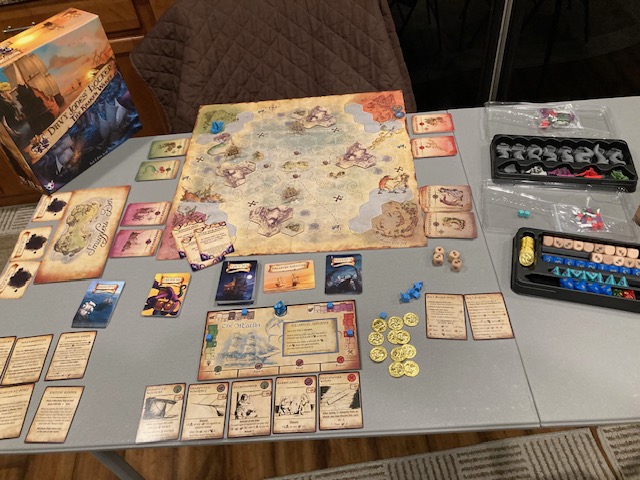
There are lots of ways to upgrade your ship: You can also Hunt or Explore A Shipwreck, which you almost only want to do with someone else: failure at those actions can really damage your ship.
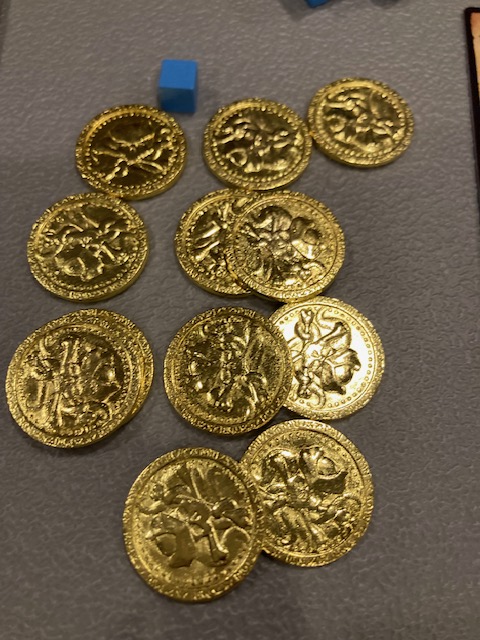
Gold is very important in Act I: you can usually get some really great upgrades at the Markets if you have enough gold. Unfortunately, you don’t have a lot of gold to start of the game, so a lot of the actions in the game have you “take a chance” to try and get some gold.
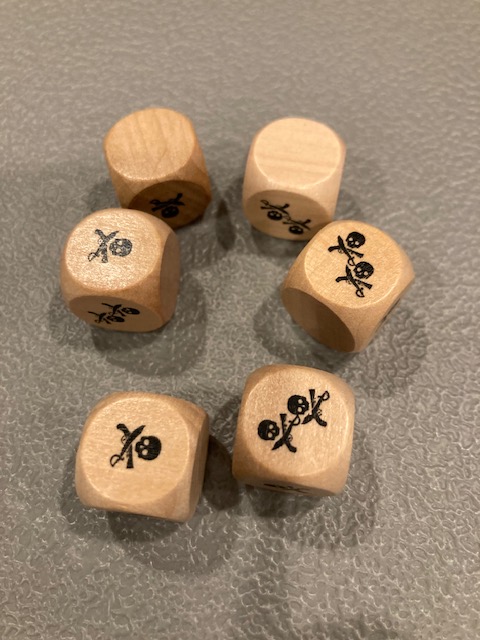
Most of the actions in Act I have you rolling the Fortune Dice (the wooden dice, see above) to attempt things: you have to get a certain number of successes to succeed: each Skull is a success. (The Combat also uses these dice). Note the distribution: 2 empties (failures), 2 single successes, and 2 double-successes.
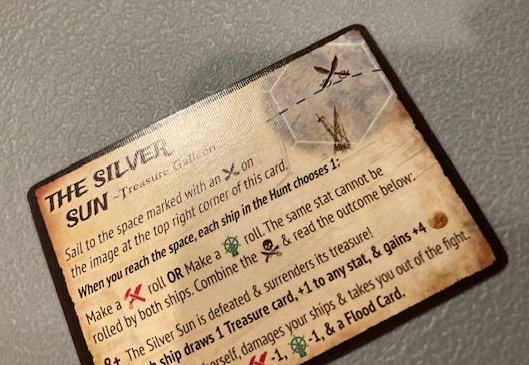
For example, when Teresa and I went after the Silver Sun (A Treasure Galleon from a Hunt action), we had to roll 8+ successes in a combined Sail and Repair roll (where the stat indicates how many dice you get to roll). A failure was not good, but a success would get us some good booty!
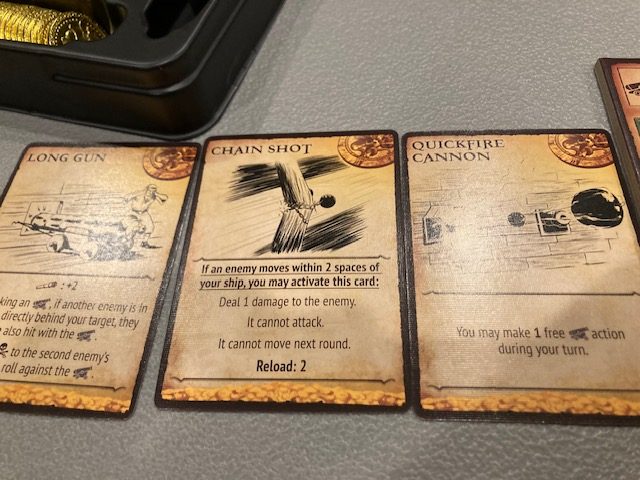
Most of the time, the result of success is Gold or a minor stat boost, but you can also get Treasure! Treasures in the game can be amazing and really help you in the final combat. The Chain Shot Treasure (above) was critical to one of our wins!
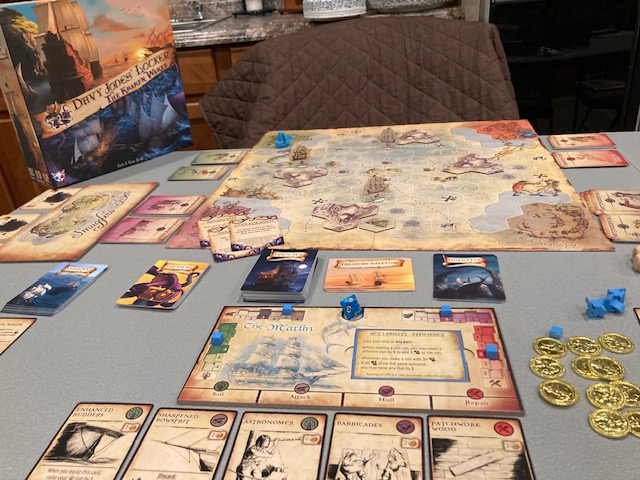
As you explore and plunder and go to different ports, you will have to sail out on the Open Seas: that has its own risks and rewards! You have to draw an Open Seas card everytime you are out at sea:
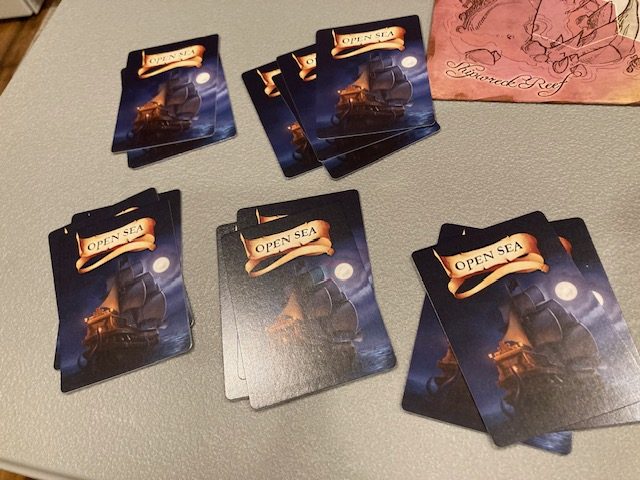
Generally, the Open Seas cards are challenges for the pirates (which may result in some gold), but as the game progresses, you may accidentally draw a Kraken Advances card from the Open Seas deck:
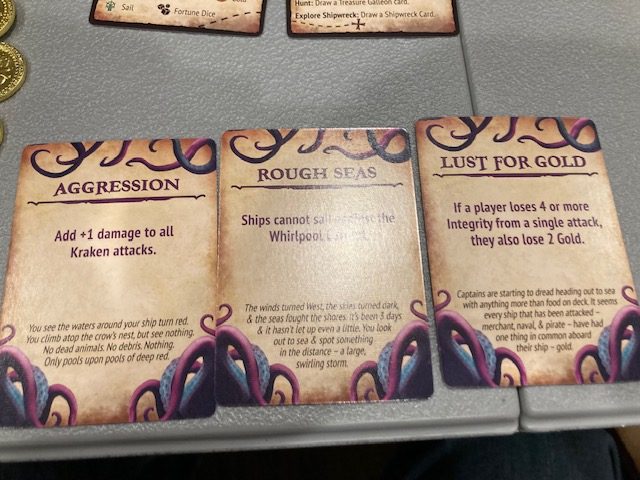
If you ever draw 3 Kraken Advances cards from the Open Sea deck, you immediately begin Act II! Most of the time, though, Act II starts after all 6 Events have come out.

Either way, you hope you and your fellow pirates have upgraded your ships enough! Act II is starting!
Act II Set-Up
Before you can get to Act II, you actually have quite a bit of set-up:
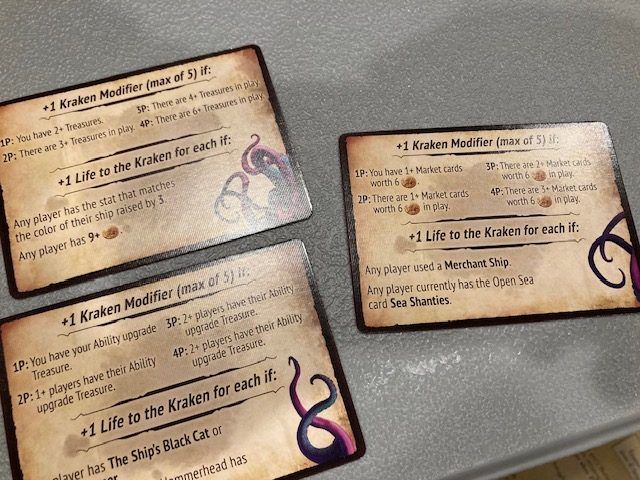
Before Act II officially starts, players have to turn over the Black Spot cards (see above) and discover how many Kraken Modifiers are used to augment the Kraken!
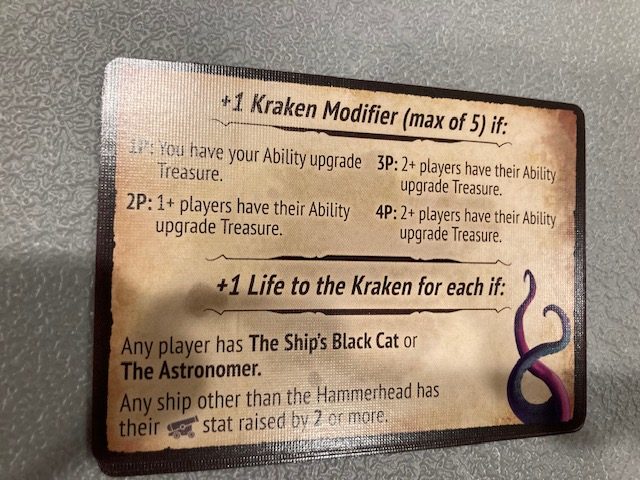
Each card will potentially up the Kraken’s starting hit points or add a new Kraken Modifier. Basically, these cards are a balancing factor: if you did really well in Act I, well, the Kraken gets that much harder!

In my first solo game, I did “ok” in the upgrade phase, and got 5 Kraken Modifiers and a few extra hit points.
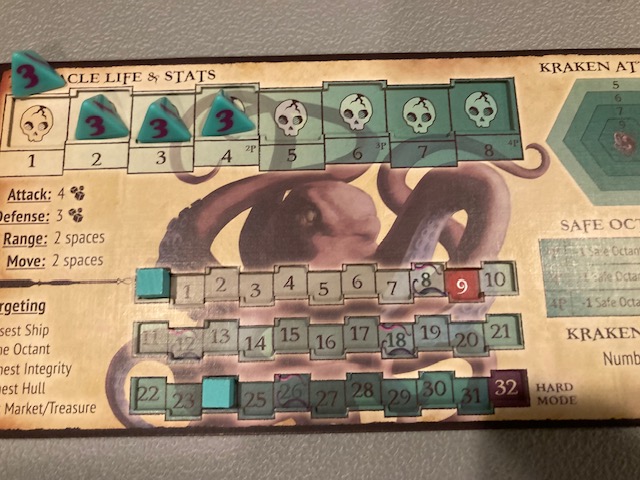
The Kraken has a number of tentacles and hit point based on the number of players. See the board above: a solo game has 4 tentacles, and my starting hit points were 24! Note that they did a great job of notating a lot of things on the board: the tentacles attack, defense, range, and move! The 4-sided dice notate the tentacle hit points (0-3).
Gameplay: Act II

Act II is all about trying to take down the Kraken and his tentacles!

A Whirlpool starts the turn: this pushes the ships around the whirlpool and has some “bad stuff” happen.
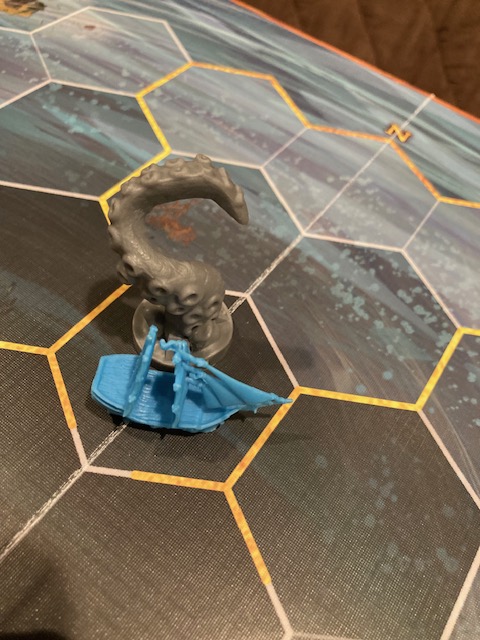
Next, the tentacles move and attack! You’ll notice each tentacle is numbered (and distinct).
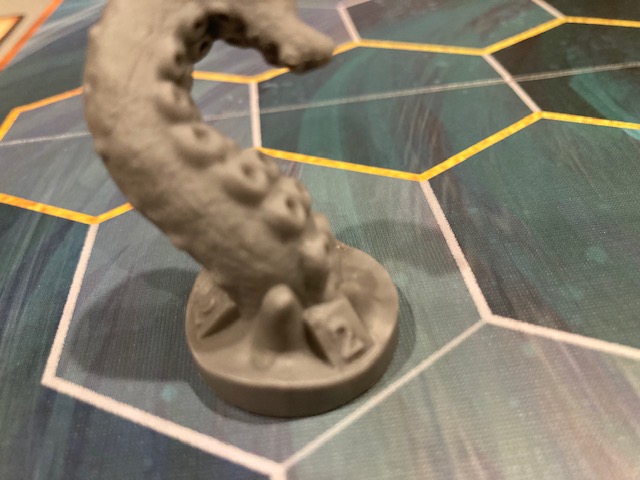
After the tentacles move and attack, the Kraken’s head attacks (now there’s a sentence you don’t hear every day)!
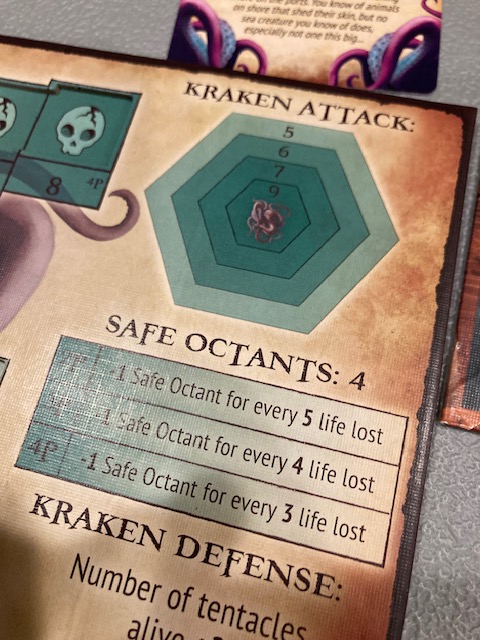
There’s no dice rolling for the Kraken attack: the Kraken just attacks every ship on the board at once and does either 5, 6, 7, or 9 damaage, depending on how close you are to the head! See the octant board above. (You still get to roll hull for defense)
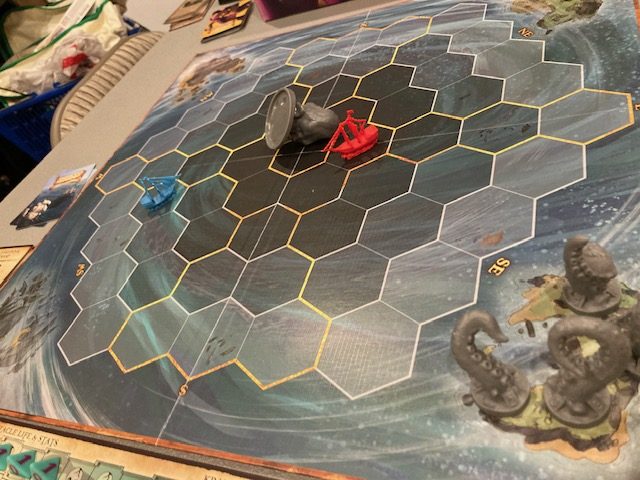
After all that, if the players still survived, they get 3 actions to move and attack the tentacles and the head! To win, players must take out the head with a direct attack! Killing tentacles is useful too, as each killed tentacle does 1 damage to the Kraken and the Kraken head defense is the number of tentacles in play + 2.
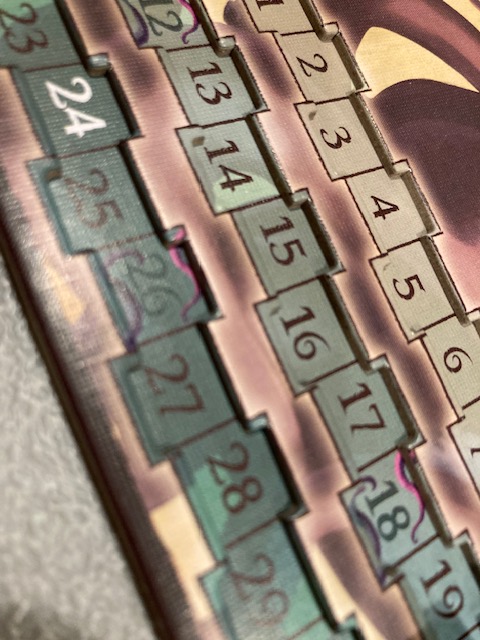
If this sounds too easy, it’s not. Tentacles regenerate once the Kraken gets lower and lower on hit points. Note the 18 and 26 above: they little tentacles on them! Teresa equated this to a video game: as you kill more and more tentacles, they respawn!
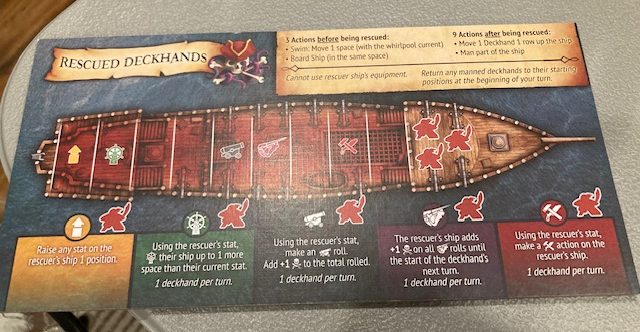
If , at any point, your ship sinks, you are not out of the game! The other player can still rescue your deckhands and you can hep augment the remaining ships! Players win if they take out the Kraken or lose if ships are sunk!
Solo Play

So, there are solo rules: (congratulations on Saunders’ Law). Unfortunately, they are relegated to their own page after you have “absorbed” the rest of the rules. I think this is disservice to the game: given how many rules there are in the game, I think it would behoove the rulebook to have a better face for the solo gamer. I am absolutely glad I learned the game before I brought it out to my friends, so I was very glad for a solo mode. I can’t imagine crunching through this game, learning as you go in a 4-Player game!

Act I moved pretty well: I had fun exploring and looking around the board. It wasn’t too much work. I will say that the special rules for Hunting and Shipwrecks slowed the game to a crawl because those rules have to change more substantially for the solo player: I had to apply the changes for the solo rules (which are not trivial) to the original rules (which are not trivial): this was quite a bit of work.

Act II feels like video game fight! Take out the Kraken! It was a little bit of a slog, until I realized I missed one very important rule: gold can be used for re-rolls! That’s very helpful! But even with that, I was very worried (and I still am, a little), that there is too much randomness in this game.

In Act I, gold is used to buy stuff. In Act II, your remaining gold is used for re-rolls: And this was absolutely essentially to realize! Without this one rule, this game is a completely random slog and I don’t want to play it again. BUT, with the gold letting you re-roll when you want, it really feels a lot better. I was about ready to chuck the game in the garbage during Act II, until I realized I had some choice when to re-roll! Gold is gooood! Ahhhhrrrrr!

The solo game is long: if you believe the box, it’s only 30 minutes. Nope, nope, nope: more like 2.5 hours. Granted, I put some of set-up and tear-down in there (there is a lot of stuff), but you have to: getting ready from Act I to Act II is quite a bit of work just right there! You’ll notice I had to write a section called Set-Up: Act II to cover it!
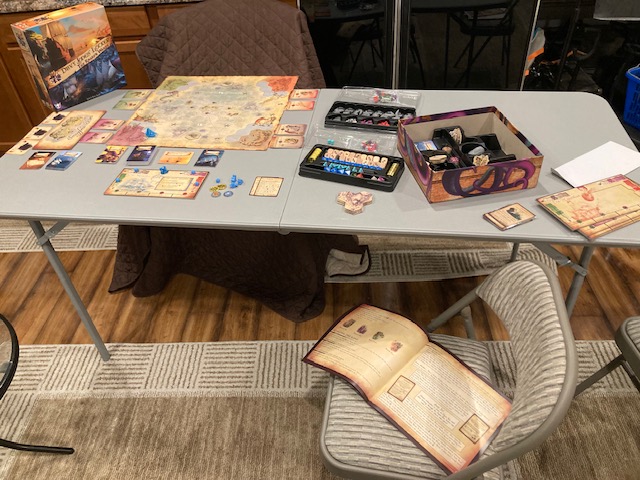
I liked the solo game, but boy was it a lot of work! There is a lot of set-up and tear-down at the start and End of Acts! Once you are playing, it’s not too much work, and it’s pretty fun but boy does it take a lot of work to get there. It’s a good solo game, I just wish it weren’t so much work between exceptional solo rules application, set-up for Act I and Act II, and teardown at the end of Act I and Act II.
Cooperative Play
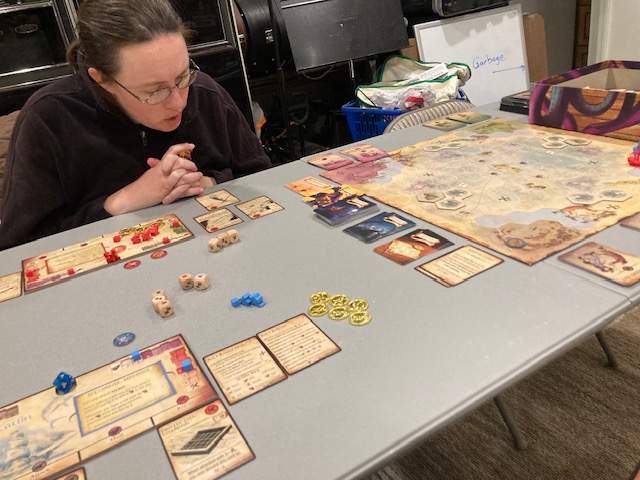
I think this is better as a cooperative game than a solo game. The work that I alluded to in the solo section can be shared between players and that relieves some of that burden, and frankly makes it more fun.
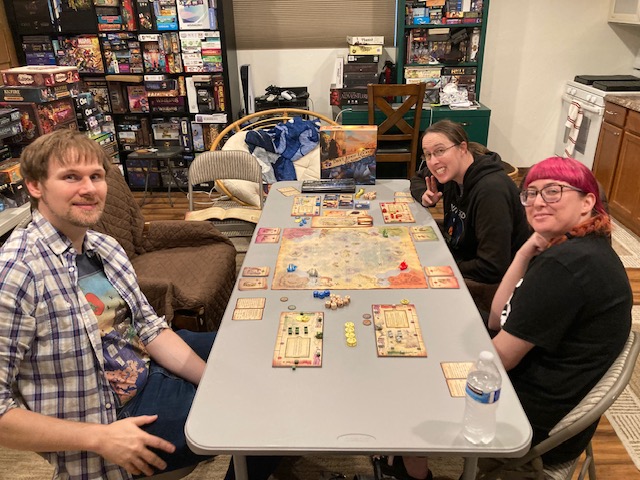
The game is a lot longer at 4-Player vs. 2-Player. The standard that we seem to see is that there is a 2 hour base, and 30 minutes per player. So, yes, it took about 4 hours for a 4-player game! In the 4-Player game, there’s not quite as much to do on your turn as you are waiting for your compatriots to play, although occasionally you do get to join them on (cooperative) Treasure Hunts!

My friend Teresa and I had a grand time playing! We were barely able to take-down the Kraken, but we did win. There was a lot more cooperation in Act II, as we had to strategize about who/when to attack. Act I was more like two solo players buffing their ships at the same time, but I will say the Treasure Hunts were “encouraged” by Event cards, and both Treasure Hunts and Shipwrecks felt more cooperative, so even then there was some cooperation.

The 4-Player game didn’t go nearly as well: partly because there was a lot of downtime between turns, and partly because the randomness overwhelmed some of us: see more details below.
Too Many Rules
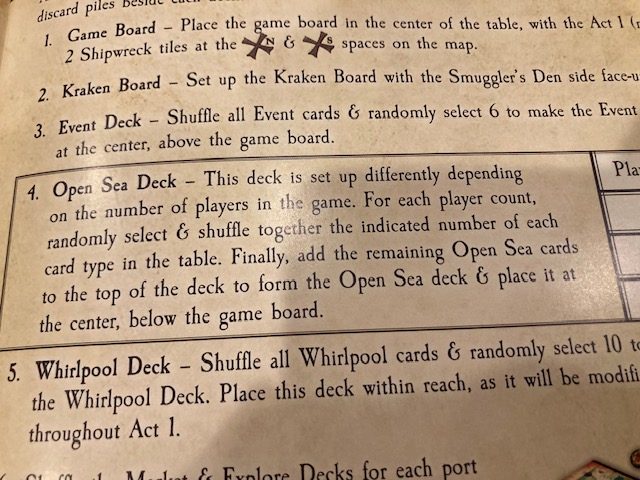
Let me say firstly: I like this game! But there are too many rules. Between the two Acts, and all the execeptions for solo mode and 5-player mode, and the deckhands and sunk ship rules, it felt very overwhelming. Some of that will go away as you play more, but I think if any nontrivial amount of time passes between plays, you will have to relearn a lot of stuff.

Having said that, in general the game did a pretty good job of helping out with Player Summaries (these were quite good, see above) and having rules on the boards (especially the Kraken board).
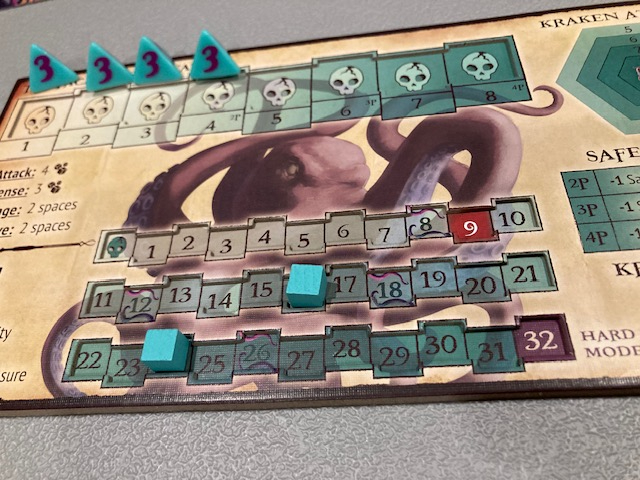
The Deckhand rules are probably the most work in the game: I understand why the game has these rules, as it’s too easy for a player to just die at the hands (or tentacles) of the Kraken and remove him from the game (not fun!)

I like the idea of the Rescued Deckhands, but it adds so many rules to a game already swimming (no pun intended) in rules. I didn’t even need them in the first few games I played, but I find myself dreading when I have to apply them. I will say, when all of us except Andrew sank in a 4-Player game, having the Deckhand rules still kinda kept us involved. It was frustrating having yet another set of rules, but it kept us involved. So, maybe it was a wash?

I like this game, but be very aware that there are a lot of rules (36 pages) and you will have to spend some time to get through them.
Theme
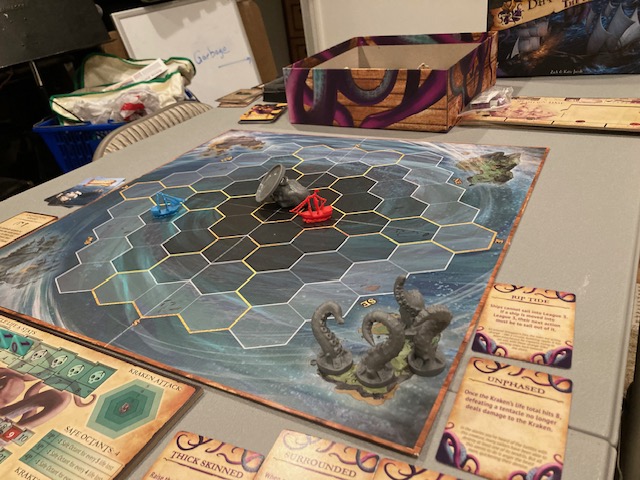
The theme really does drip from this game. The encounters in Act I feel very piratey, the art leans into the pirate theme, the cards seem to have just enough text to make the game feel piratey (but not too much text to be distracting), and the Kraken fight feels like the end of a pirate movie! If you want a thematic pirate game, this delivers.
House Rules

My main problem with the game is that there might be too much randomness to the game. If you do poorly in Act I, even with the balancing of the Block Spot cards, it just feels like you are going in with significantly reduced chances. A very simple way to help with that: make it so Gold can be spent for re-rolls in Act I! That way, if you feel like Act I is too random, it can be mitigated. This also makes the game more consistent: “You may spend one Gold to re-roll one die at any time”.
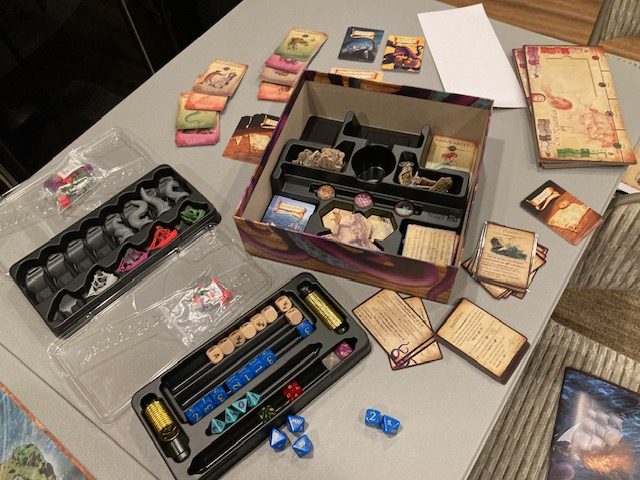
The inconsistencies between Act I and Act II were a little frustrating sometimes. (“Wait, can I spend a stat to not sink in Act II? Or was that just Act I?” ) Making gold always useful as a re-roll seems to make sense.

Also, consider the Rescued Deckhands rules: The entire purpose of the Rescued Deckhands is to keep players involved if their Ship sinks in Act II: And this will happen! It happened to all of us except 1 in a 4-Player game! The game can really feel random sometimes and one player gets all the Tentacles! I love the idea of the Rescued Deckhands, but it is SO MANY Rules after learning the Act II rules! A simple way around them: Give the players a “Witch Brew”. If any player ever sinks, the players can use the “Witch Brew” to immediately resurrect anywhere at full health. I love the idea of the Rescued Deckhands, but it is so much more work in a game that already has a lot of work!!
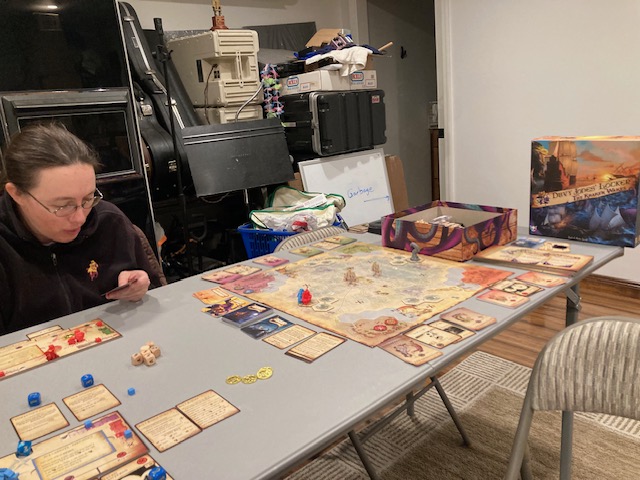
These are just suggestions. Feel free to ignore. I do think the using gold for a re-rolls should permeate the game: it gives the players choice when they need it, it simplifies/consistentifies the rules , and it makes more juicy choices: “Do I save Gold to buy cool upgrades, or do I use gold to re-roll to pass this encounter?”
Conclusion: A Tale of Two Pirates
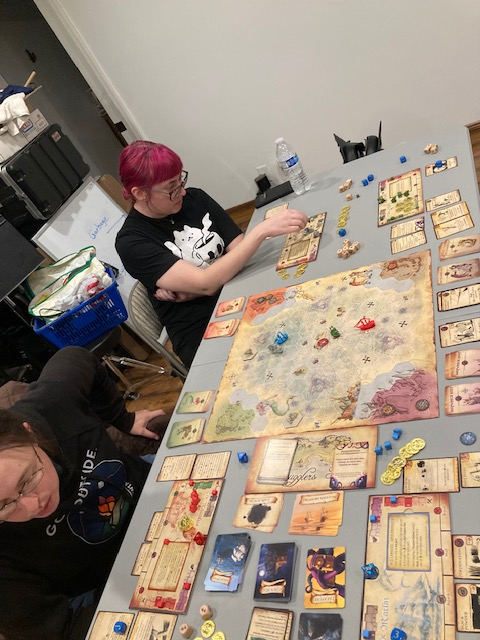
Sara played this game and had a miserable time: her Act I succumbed to bad rolls, and she was never as able to get anything going. Sara had to watch everyone else do well in Act I, then she immediately died at the start of Act II. She disengaged the whole time. In the words of Sara, “There were too many rules, the games was far too random, and it was way too long. I hated this game”.

Teresa has played this game multiple times (including with Sara), and Teresa is interested in playing again. She loved the theme and the dice-rolling: she liked living in this world. “Can we play again when it’s just the two of us?”
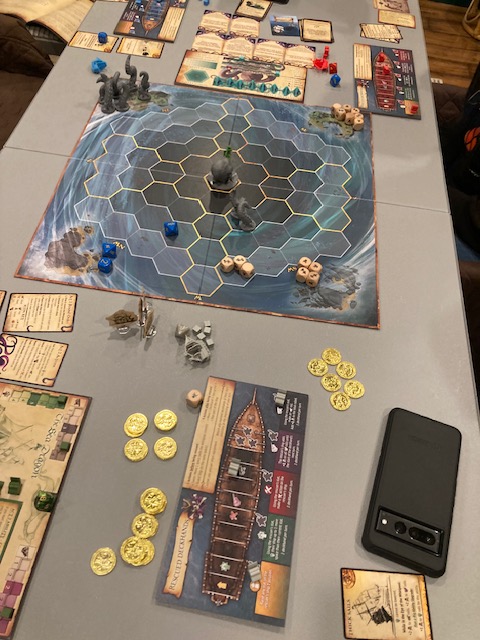
At the very start of this review, we asked: Would Davy Jones’ Locker: The Kraken Wakes make our Top 10 Cooperative Swashbuckling Games? It would, but just just barely. Teresa liked it better than Dead Men Tell No Tales, and Andrew and Rich were generally positive about it, So, that would put Davy Jones’ Locker: The Kraken Wakes in the very bottom of our Top 10 Cooperative Swashbuckling Games (probably supplanting Pirate Republic)!

This game has amazing components and feels very piratey! The theme is all throughout the game!

If you think you can handle the randomness and swingy nature of this game (almost everything is a dice roll), and if you enjoy living in this vey thematic pirate universe (the games are long), then this can be a game for you. Be aware of what this is! Sara hated the game because of the randomness, but Teresa liked living in this world! Andrew and I are somewhere in the middle.
- Sara: Hated it. 3/10
- Andrew: Enjoyed it, positive feelings but noticed how random it can be. 5.5-6/10
- Rich: Both hated it and liked it over many games. There is too much randomness for such a long game, but there were some great moments and theme in here. Somewhere between 5 and 7/10! (quite a range)
- Teresa: Liked it. 6.5/10 maybe a 7/10, would recommend it and want to play it again as a 2-Player game

We’ll finish by saying that the solo game may be a little too much work to play a lot, the game can be too long and too random, and the rules could use a few rejiggers (both having too many rules and needing a minor rethink), but this could be a game for you because it really does evoke a very piratey theme: there’s still a lot to like in the box.















































































































































































